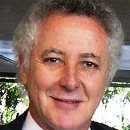Day 1 :
Keynote Forum
Liz Bardelas
Bea Professional Brands, LLC., USA
Keynote: Best practice strategies: Turning your ideas into global business
Time : 09:35-10:00

Biography:
Liz Bardelas is Co-Founder and CEO of Bea Skincare and Cosmetics, a premium-brand New York-based family-owned company specializing in vitamin-based, anti-aging, pure-botanical skincare and cosmetics for normal to sensitive skins; founder of B2B Global Healthcare Group, a health care consulting and project management company; managing partner of California Vein and Vascular, a vascular surgery practice; and CEO of Pricepharmer, a pharmaceutical and drug store app that puts drugstores in front of consumers at the exact time they are looking for information about their prescription. She attended De La Salle University, Columbia University and Pepperdine University.
Abstract:
How do you launch a blockbuster product? How do you become the company that will put you out of business? Companies pride themselves on giving their customers what they ask for. Selling what the shopper wants guarantee success: smarter phones, smarter cars, gluten-free products, e-cigarettes, bigger iPhones and smaller iPads. What is your most valuable resource? Time! How do you increase productivity and make more money with the time you have? In retail, it has been predicted that productivity will increase by one-third in developed economies and double in emerging economies between 2012 and 2025. Therefore, selecting the richest opportunities from a very long list of possibilities is critical. In this talk, Liz Bardelas, Founder and CEO of Bea Skincare and Cosmetics, will share how a home-grown American retailer of branded skincare and cosmetics have identified with a wide range of shoppers. In just two years since its inception, Bea products are sold at prestigious plastic surgery and dermatology offices in the US; online on Amazon.com; IPO-giant Alibaba’s Chinese e-commerce site Taobao.com and its US e-commerce site, 11main.com; and this year, Bea will launch on Japan’s largest e-commerce platform. Successful entrepreneurs share their stories of how they launched and grew a company. This talk will discuss Bea’s strategy to globalization, the role of innovation in leadership and business, and the 3-pronged approach that Bea Skincare and Cosmetics used to engage multiple sales channels, how they work on breaking down language and cultural barriers, and how inexpensive customer input equals costly predictive analytics.
Keynote Forum
Hilton Becker
Hilton Becker M.D-Clinic of Plastic Surgery
Keynote: Minimizing scars in breast lift surgery
Time : 10:00-10:25

Biography:
Hilton Becker has been in plastic surgery practice since 1981 and is certified by the American Board of Plastic Surgery. He received his medical degree from the University of Witwatersand, Johannesburg, South Africa, and completed his plastic surgery residency at the Medical College of Virginia. He specializes in reconstructive and cosmetic surgery of the breasts, facial rejuvenation, and liposuction. He has developed several medical patents, including the Becker Adjustable Breast Implant and the Becker Dissector Liposuction Cannula and a complete line of natural skin care products, always keeping the patient’s best interest in mind. He is the recipient of many awards, most notably named one of Good Housekeeping’s top Breast Cancer Reconstructive Surgeons in 1989. He remains dedicated to his cancer patients around the world. His philosophy is to exceed his patients’ needs and expectations and ensure they always receive the highest standard of care.
Abstract:
Breast lifts have traditionally been performed through an anchor incision, i.e. a scar around the areola, a vertical scar from the areola to the base of the breast, and an incision along the base of the breast. Recent improvements include the vertical scar technique and the circum-areolar technique leaving a scar around the areola only. A new technique will be presented where tightening is done under the areola, and an absorbable mesh (internal bra) is used to support the breast.
Keynote Forum
Alain Tenenbaum
Swiss Academy of Cosmetic Dermatology and Aesthetic Medicine, Switzerland
Keynote: Complications of dermal fillers and endoprosthesis
Time : 10:40-11:05

Biography:
Alain Tenenbaum, is the President of Swiss Academy of Cosmetic Dermatology and Aesthetic Medicine (SACDAM) and President of International Peeling Society(ISPC). He is a specialist in ENT (Oto Rhino Laryngology) and Facial, Plastic, Reconstructive and Cosmetic Surgery. Also, he is an inventor of Endopeel and many other peelings like Peeling de Luxe. He is a Silver medalist faculty of University of Paris, France and an International expert of Complications of Fillers and Endoprosthesis. He is known as a worldwide trainer of Aesthetic Medicine and Cosmetic Dermatology. He is an expert in SEO- Search Engines Optimization, for Aesthetic Medicine, Anti-Aging Medicine, Cosmetic Dermatology and Aesthetic Plastic Surgery. He is an active member of European Society for Cosmetic and Aesthetic Dermatology (ESCAD), European Academy of Facial Plastic Surgery (EAFPS), and FMH.
Abstract:
Most of Plastic Surgeons, Dermatologists believe permanent fillers are dangerous and resorbable fillers are not dangerous. In fact, all kind of fillers give the same complications like granulomas, nodules, necrosis, migrations, infections, persistent oedema and so on. The most frequent complication encountered after lipofilling is Granulomas. Every patient who undergoes endoprosthesis should ultrasonography of 20 mHz and not 7.5 mHz, for the following reasons:
Keynote Forum
Angelo Rebelo
Clinica Milenio, Portugal
Keynote: Calf augmentation with implants local anesthesia
Time : 11:05-11:30

Biography:
Angelo Rebelo has concluded his medicine studies in the Faculty of Medicine of the University of Lisbon, Portugal in 1980 and he became a specialized in Plastic, Reconstructive and Aesthetic Surgery in 1990. Since 1997 he opened his own outpatient private clinic for aesthetic-plastic surgery in Lisbon, Portugal, in the last 18 years, he’s in exclusivity at Clinica Milénio in Lisbon - Portugal, as Clinic Director and Cosmetic Surgeon. He is precursor in several techniques of Cosmetic Surgery performed under Local Tumescent Anaesthesia and outpatient. Internationally, he has been invited to teach and perform several surgical demonstrations in many countries. He is frequently sought out by the medias as an authority in his field. His surgical techniques and advancements have been the subjects of interviews in Portuguese and international media, he’s also author of numerous videos, lectures and articles presented at congresses and scientific journals. He is also an active member of several Professional Societies and Associations through the world.
Abstract:
Is a very popular procedure, which will create cosmetic fullness in the lower leg and can help those men and women who, even after extensive muscular development, can’t achieve the calf muscle toning which they desire. Many men and women feel dissatisfied with the shape and size of their calf muscles. Despite exercise, diet and training, sometimes it is difficult to achieve the calf muscle tone desired. Calf implants are also suitable for lower leg sculpting and to correct any muscle imbalance, so you can enjoy shapely, firm calf muscles that add to the definition of your overall leg shape. The goal is to create cosmetic fullness in the lower leg, enhance the legs. The surgery is performed upon a patient under local tumescent anesthesia with sedation as an outpatient. The anesthetic formulas are:
Oral sedation
(30 – 60 min before “PER-OSâ€)IV Sedation (By Anesthesiologist)
Anesthesic Solution
Postoperative Care
Use for about 3 weeks comfortable shoes that have heels. Men usually wear boots with higher heels. Heels reduce the stretch on the calf muscles during recovery. No dress. Panties 70 DIN 3 weeks. Antibiotic IV intra op and oral one week. Analgesic S.O.S.Postoperative Care
AdvantagesAmbulatory, less or no bleeding, better recovery, less expensive and long term results.